Organizational Behaviour: Culture, Teams, and Motivation at BBC
VerifiedAdded on 2024/05/17
|21
|4382
|227
Report
AI Summary
This report provides an in-depth analysis of organizational behaviour within the BBC, focusing on the impacts of culture, power, and politics on employee behaviour. It uses Handy's cultural topology to identify and discuss the BBC's earlier organizational culture, highlighting shifts from power culture to role culture in response to internal issues. The report also explores how motivation, through content and process theories, can improve team effectiveness and help achieve organizational goals. Furthermore, it identifies different types of teams, discusses theories for building effective teams within the BBC, and addresses barriers to performance, ultimately aiming to improve overall productivity and create a better working environment. This assignment is available on Desklib, a platform offering a range of study tools and resources for students.
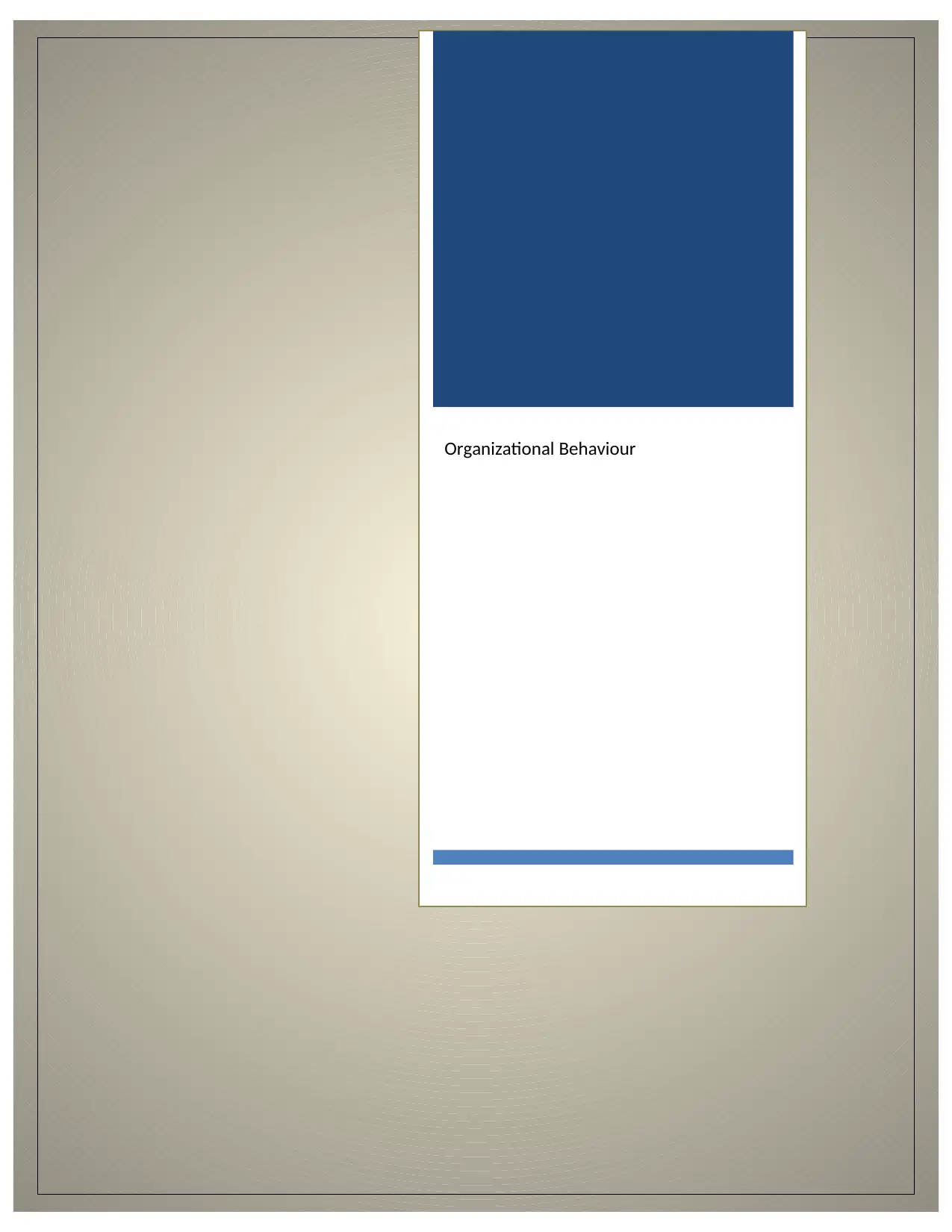
Organizational Behaviour
Paraphrase This Document
Need a fresh take? Get an instant paraphrase of this document with our AI Paraphraser
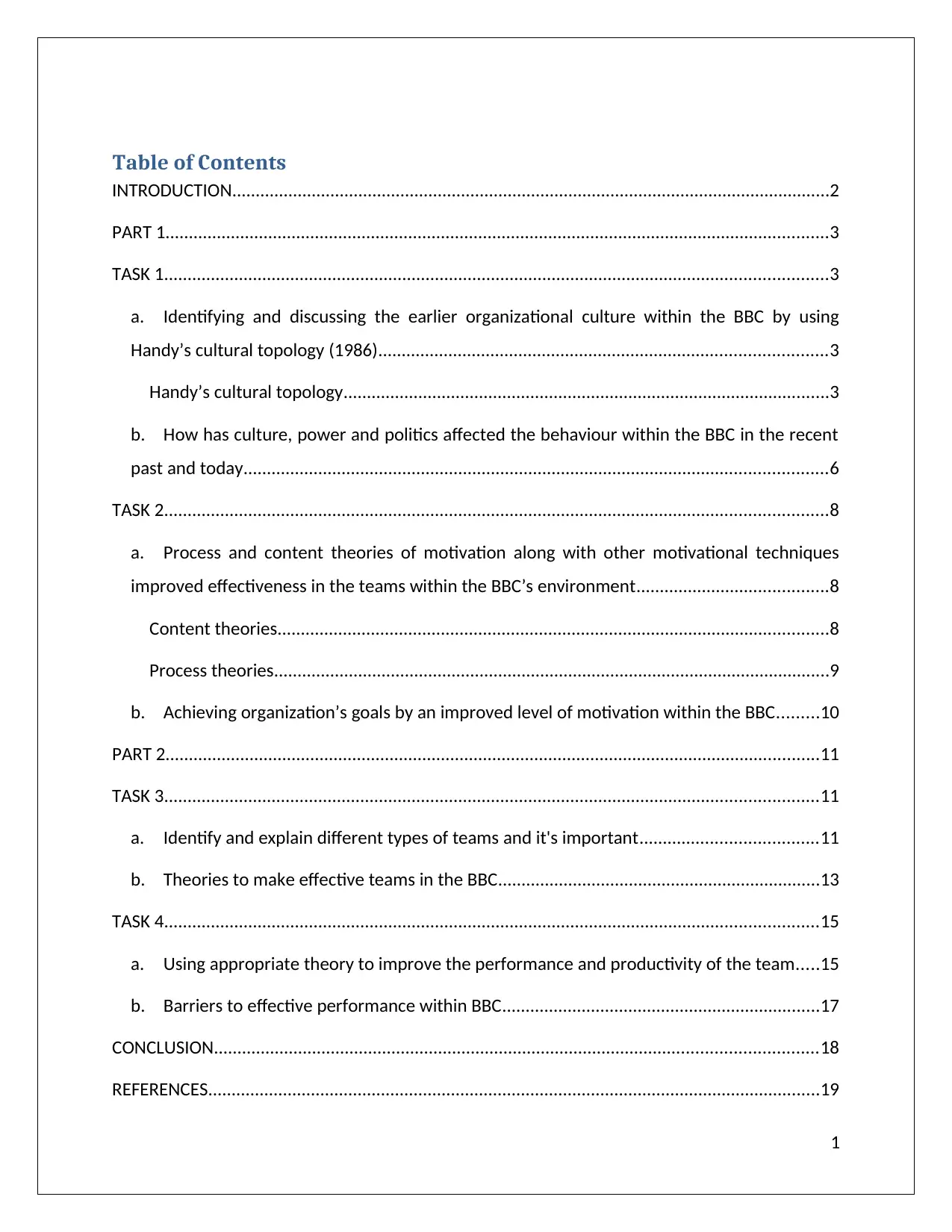
Table of Contents
INTRODUCTION................................................................................................................................2
PART 1..............................................................................................................................................3
TASK 1..............................................................................................................................................3
a. Identifying and discussing the earlier organizational culture within the BBC by using
Handy’s cultural topology (1986)................................................................................................3
Handy’s cultural topology........................................................................................................3
b. How has culture, power and politics affected the behaviour within the BBC in the recent
past and today.............................................................................................................................6
TASK 2..............................................................................................................................................8
a. Process and content theories of motivation along with other motivational techniques
improved effectiveness in the teams within the BBC’s environment.........................................8
Content theories......................................................................................................................8
Process theories.......................................................................................................................9
b. Achieving organization’s goals by an improved level of motivation within the BBC.........10
PART 2............................................................................................................................................11
TASK 3............................................................................................................................................11
a. Identify and explain different types of teams and it's important......................................11
b. Theories to make effective teams in the BBC.....................................................................13
TASK 4............................................................................................................................................15
a. Using appropriate theory to improve the performance and productivity of the team.....15
b. Barriers to effective performance within BBC....................................................................17
CONCLUSION.................................................................................................................................18
REFERENCES...................................................................................................................................19
1
INTRODUCTION................................................................................................................................2
PART 1..............................................................................................................................................3
TASK 1..............................................................................................................................................3
a. Identifying and discussing the earlier organizational culture within the BBC by using
Handy’s cultural topology (1986)................................................................................................3
Handy’s cultural topology........................................................................................................3
b. How has culture, power and politics affected the behaviour within the BBC in the recent
past and today.............................................................................................................................6
TASK 2..............................................................................................................................................8
a. Process and content theories of motivation along with other motivational techniques
improved effectiveness in the teams within the BBC’s environment.........................................8
Content theories......................................................................................................................8
Process theories.......................................................................................................................9
b. Achieving organization’s goals by an improved level of motivation within the BBC.........10
PART 2............................................................................................................................................11
TASK 3............................................................................................................................................11
a. Identify and explain different types of teams and it's important......................................11
b. Theories to make effective teams in the BBC.....................................................................13
TASK 4............................................................................................................................................15
a. Using appropriate theory to improve the performance and productivity of the team.....15
b. Barriers to effective performance within BBC....................................................................17
CONCLUSION.................................................................................................................................18
REFERENCES...................................................................................................................................19
1
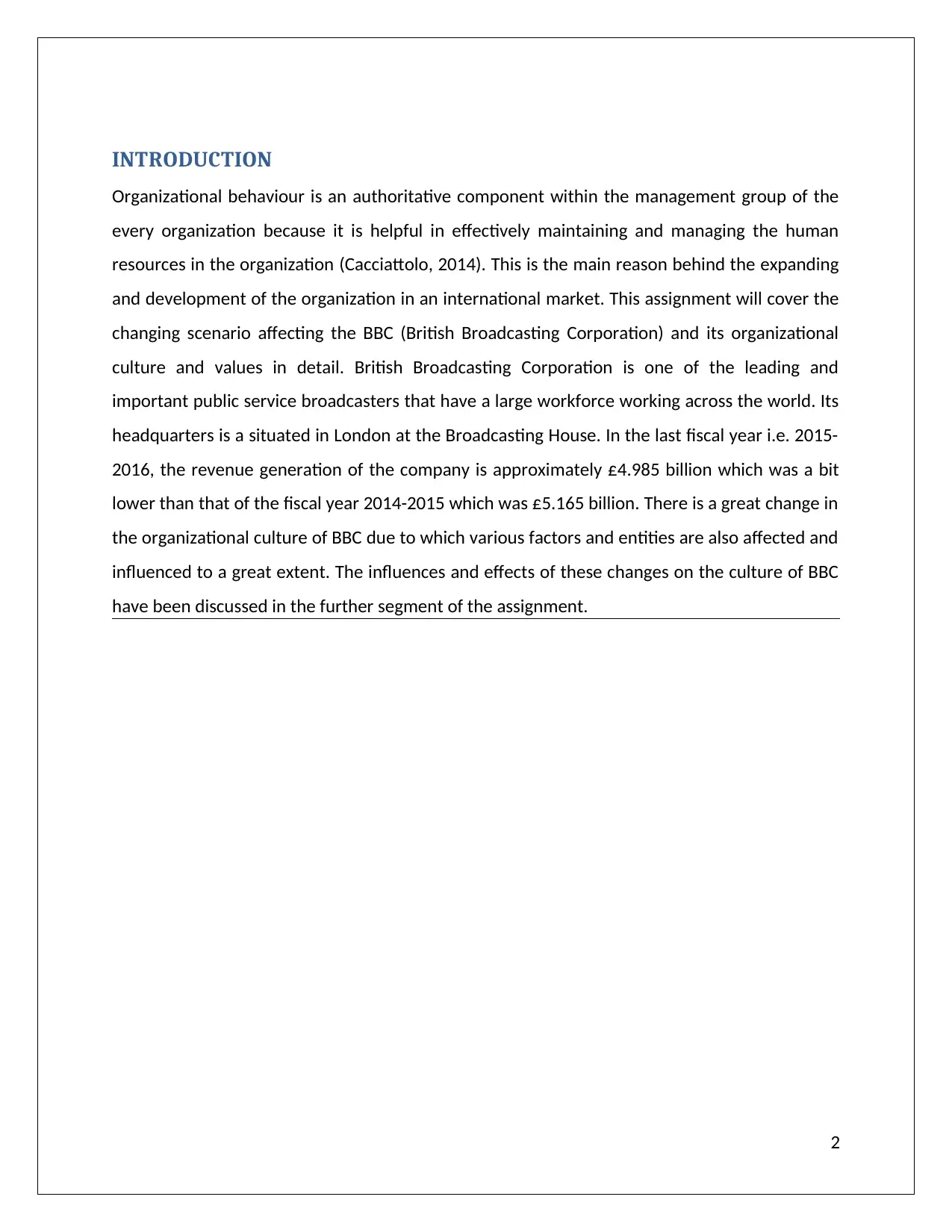
INTRODUCTION
Organizational behaviour is an authoritative component within the management group of the
every organization because it is helpful in effectively maintaining and managing the human
resources in the organization (Cacciattolo, 2014). This is the main reason behind the expanding
and development of the organization in an international market. This assignment will cover the
changing scenario affecting the BBC (British Broadcasting Corporation) and its organizational
culture and values in detail. British Broadcasting Corporation is one of the leading and
important public service broadcasters that have a large workforce working across the world. Its
headquarters is a situated in London at the Broadcasting House. In the last fiscal year i.e. 2015-
2016, the revenue generation of the company is approximately £4.985 billion which was a bit
lower than that of the fiscal year 2014-2015 which was £5.165 billion. There is a great change in
the organizational culture of BBC due to which various factors and entities are also affected and
influenced to a great extent. The influences and effects of these changes on the culture of BBC
have been discussed in the further segment of the assignment.
2
Organizational behaviour is an authoritative component within the management group of the
every organization because it is helpful in effectively maintaining and managing the human
resources in the organization (Cacciattolo, 2014). This is the main reason behind the expanding
and development of the organization in an international market. This assignment will cover the
changing scenario affecting the BBC (British Broadcasting Corporation) and its organizational
culture and values in detail. British Broadcasting Corporation is one of the leading and
important public service broadcasters that have a large workforce working across the world. Its
headquarters is a situated in London at the Broadcasting House. In the last fiscal year i.e. 2015-
2016, the revenue generation of the company is approximately £4.985 billion which was a bit
lower than that of the fiscal year 2014-2015 which was £5.165 billion. There is a great change in
the organizational culture of BBC due to which various factors and entities are also affected and
influenced to a great extent. The influences and effects of these changes on the culture of BBC
have been discussed in the further segment of the assignment.
2
⊘ This is a preview!⊘
Do you want full access?
Subscribe today to unlock all pages.

Trusted by 1+ million students worldwide
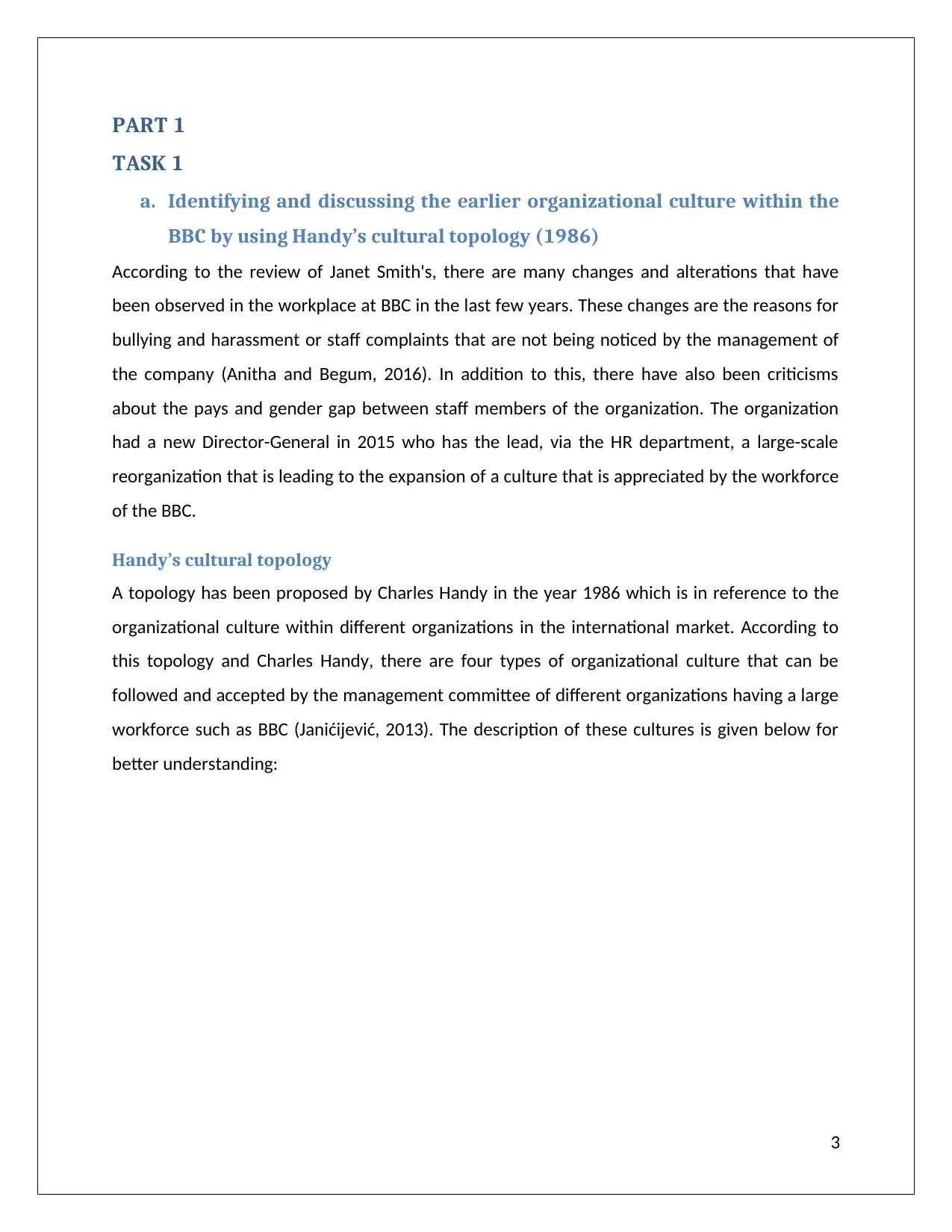
PART 1
TASK 1
a. Identifying and discussing the earlier organizational culture within the
BBC by using Handy’s cultural topology (1986)
According to the review of Janet Smith's, there are many changes and alterations that have
been observed in the workplace at BBC in the last few years. These changes are the reasons for
bullying and harassment or staff complaints that are not being noticed by the management of
the company (Anitha and Begum, 2016). In addition to this, there have also been criticisms
about the pays and gender gap between staff members of the organization. The organization
had a new Director-General in 2015 who has the lead, via the HR department, a large-scale
reorganization that is leading to the expansion of a culture that is appreciated by the workforce
of the BBC.
Handy’s cultural topology
A topology has been proposed by Charles Handy in the year 1986 which is in reference to the
organizational culture within different organizations in the international market. According to
this topology and Charles Handy, there are four types of organizational culture that can be
followed and accepted by the management committee of different organizations having a large
workforce such as BBC (Janićijević, 2013). The description of these cultures is given below for
better understanding:
3
TASK 1
a. Identifying and discussing the earlier organizational culture within the
BBC by using Handy’s cultural topology (1986)
According to the review of Janet Smith's, there are many changes and alterations that have
been observed in the workplace at BBC in the last few years. These changes are the reasons for
bullying and harassment or staff complaints that are not being noticed by the management of
the company (Anitha and Begum, 2016). In addition to this, there have also been criticisms
about the pays and gender gap between staff members of the organization. The organization
had a new Director-General in 2015 who has the lead, via the HR department, a large-scale
reorganization that is leading to the expansion of a culture that is appreciated by the workforce
of the BBC.
Handy’s cultural topology
A topology has been proposed by Charles Handy in the year 1986 which is in reference to the
organizational culture within different organizations in the international market. According to
this topology and Charles Handy, there are four types of organizational culture that can be
followed and accepted by the management committee of different organizations having a large
workforce such as BBC (Janićijević, 2013). The description of these cultures is given below for
better understanding:
3
Paraphrase This Document
Need a fresh take? Get an instant paraphrase of this document with our AI Paraphraser
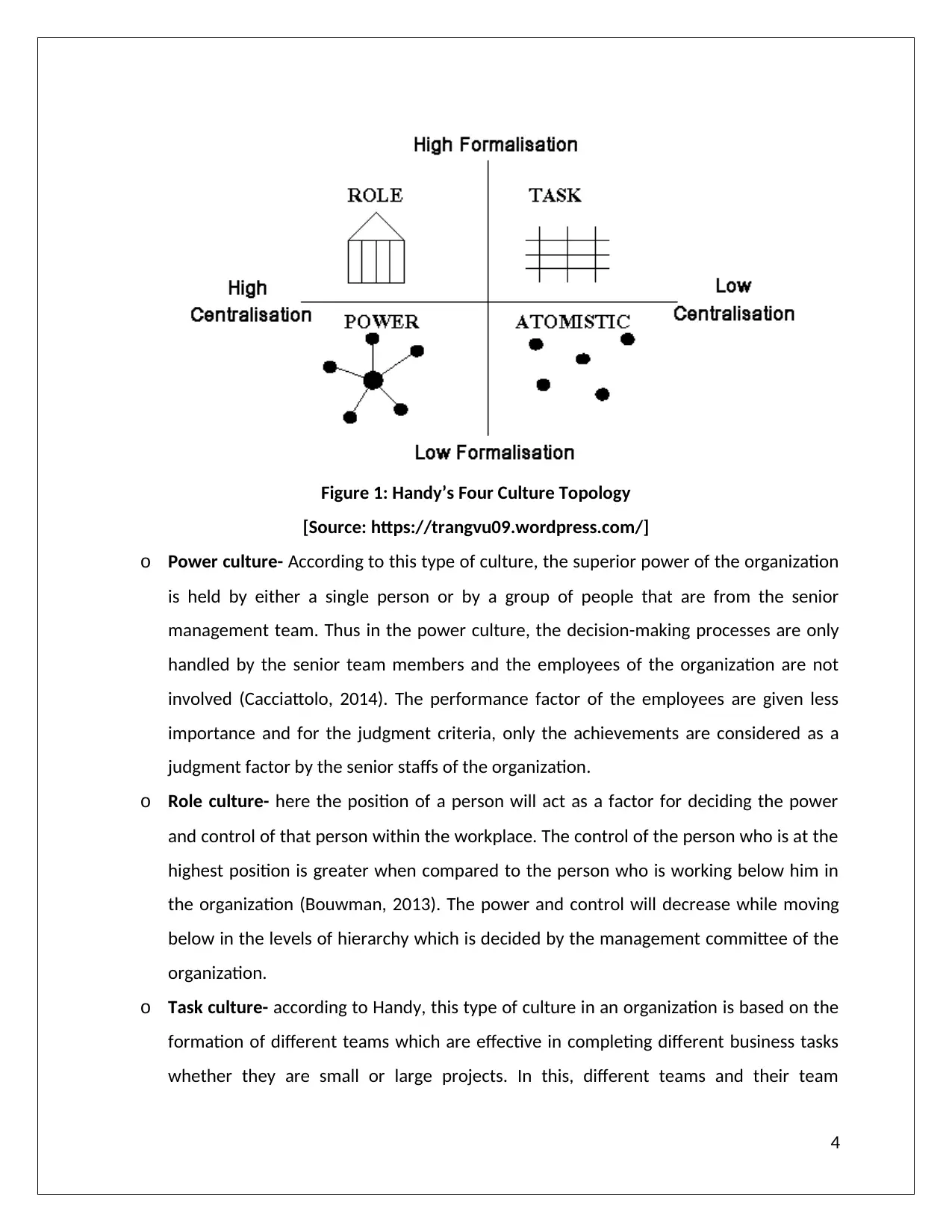
Figure 1: Handy’s Four Culture Topology
[Source: https://trangvu09.wordpress.com/]
o Power culture- According to this type of culture, the superior power of the organization
is held by either a single person or by a group of people that are from the senior
management team. Thus in the power culture, the decision-making processes are only
handled by the senior team members and the employees of the organization are not
involved (Cacciattolo, 2014). The performance factor of the employees are given less
importance and for the judgment criteria, only the achievements are considered as a
judgment factor by the senior staffs of the organization.
o Role culture- here the position of a person will act as a factor for deciding the power
and control of that person within the workplace. The control of the person who is at the
highest position is greater when compared to the person who is working below him in
the organization (Bouwman, 2013). The power and control will decrease while moving
below in the levels of hierarchy which is decided by the management committee of the
organization.
o Task culture- according to Handy, this type of culture in an organization is based on the
formation of different teams which are effective in completing different business tasks
whether they are small or large projects. In this, different teams and their team
4
[Source: https://trangvu09.wordpress.com/]
o Power culture- According to this type of culture, the superior power of the organization
is held by either a single person or by a group of people that are from the senior
management team. Thus in the power culture, the decision-making processes are only
handled by the senior team members and the employees of the organization are not
involved (Cacciattolo, 2014). The performance factor of the employees are given less
importance and for the judgment criteria, only the achievements are considered as a
judgment factor by the senior staffs of the organization.
o Role culture- here the position of a person will act as a factor for deciding the power
and control of that person within the workplace. The control of the person who is at the
highest position is greater when compared to the person who is working below him in
the organization (Bouwman, 2013). The power and control will decrease while moving
below in the levels of hierarchy which is decided by the management committee of the
organization.
o Task culture- according to Handy, this type of culture in an organization is based on the
formation of different teams which are effective in completing different business tasks
whether they are small or large projects. In this, different teams and their team
4
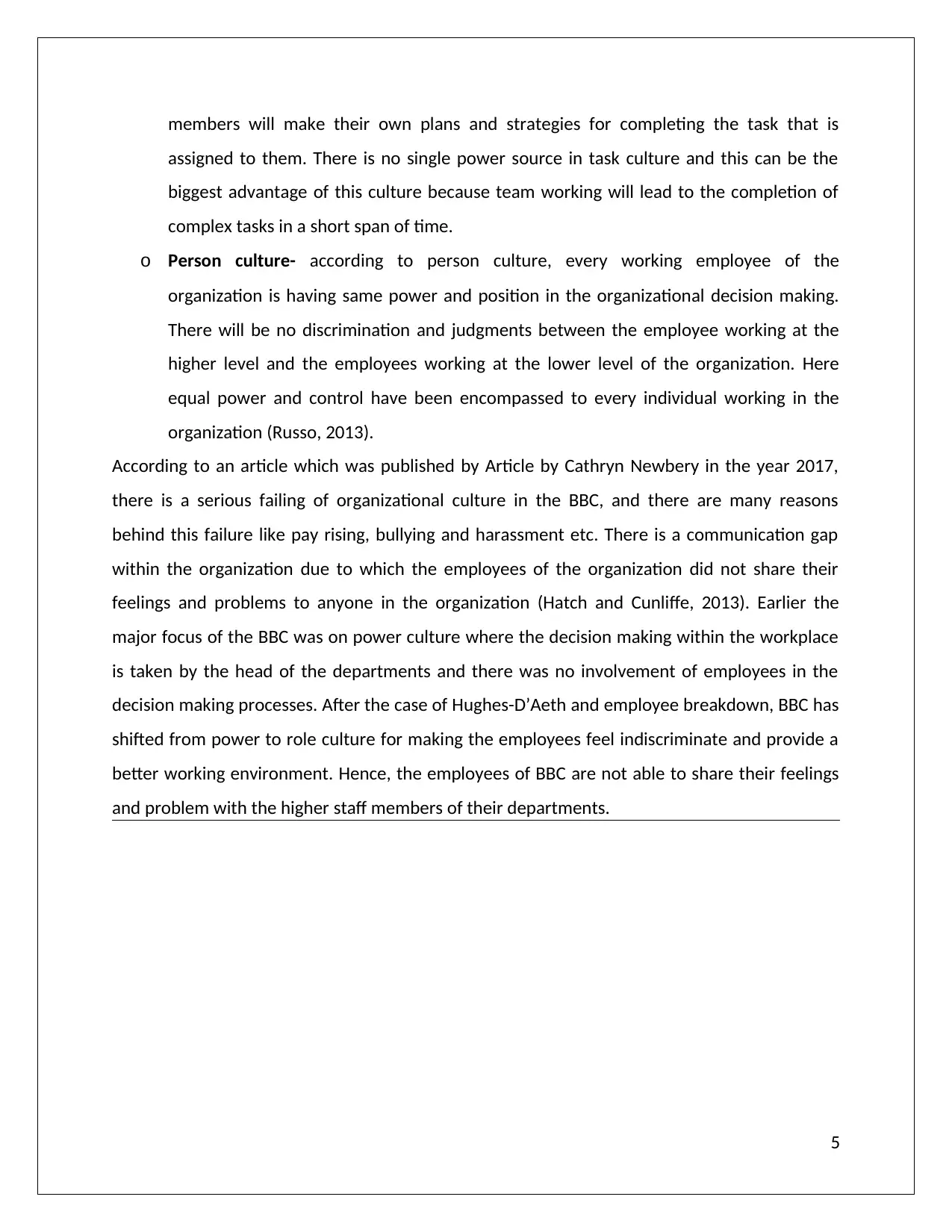
members will make their own plans and strategies for completing the task that is
assigned to them. There is no single power source in task culture and this can be the
biggest advantage of this culture because team working will lead to the completion of
complex tasks in a short span of time.
o Person culture- according to person culture, every working employee of the
organization is having same power and position in the organizational decision making.
There will be no discrimination and judgments between the employee working at the
higher level and the employees working at the lower level of the organization. Here
equal power and control have been encompassed to every individual working in the
organization (Russo, 2013).
According to an article which was published by Article by Cathryn Newbery in the year 2017,
there is a serious failing of organizational culture in the BBC, and there are many reasons
behind this failure like pay rising, bullying and harassment etc. There is a communication gap
within the organization due to which the employees of the organization did not share their
feelings and problems to anyone in the organization (Hatch and Cunliffe, 2013). Earlier the
major focus of the BBC was on power culture where the decision making within the workplace
is taken by the head of the departments and there was no involvement of employees in the
decision making processes. After the case of Hughes-D’Aeth and employee breakdown, BBC has
shifted from power to role culture for making the employees feel indiscriminate and provide a
better working environment. Hence, the employees of BBC are not able to share their feelings
and problem with the higher staff members of their departments.
5
assigned to them. There is no single power source in task culture and this can be the
biggest advantage of this culture because team working will lead to the completion of
complex tasks in a short span of time.
o Person culture- according to person culture, every working employee of the
organization is having same power and position in the organizational decision making.
There will be no discrimination and judgments between the employee working at the
higher level and the employees working at the lower level of the organization. Here
equal power and control have been encompassed to every individual working in the
organization (Russo, 2013).
According to an article which was published by Article by Cathryn Newbery in the year 2017,
there is a serious failing of organizational culture in the BBC, and there are many reasons
behind this failure like pay rising, bullying and harassment etc. There is a communication gap
within the organization due to which the employees of the organization did not share their
feelings and problems to anyone in the organization (Hatch and Cunliffe, 2013). Earlier the
major focus of the BBC was on power culture where the decision making within the workplace
is taken by the head of the departments and there was no involvement of employees in the
decision making processes. After the case of Hughes-D’Aeth and employee breakdown, BBC has
shifted from power to role culture for making the employees feel indiscriminate and provide a
better working environment. Hence, the employees of BBC are not able to share their feelings
and problem with the higher staff members of their departments.
5
⊘ This is a preview!⊘
Do you want full access?
Subscribe today to unlock all pages.

Trusted by 1+ million students worldwide
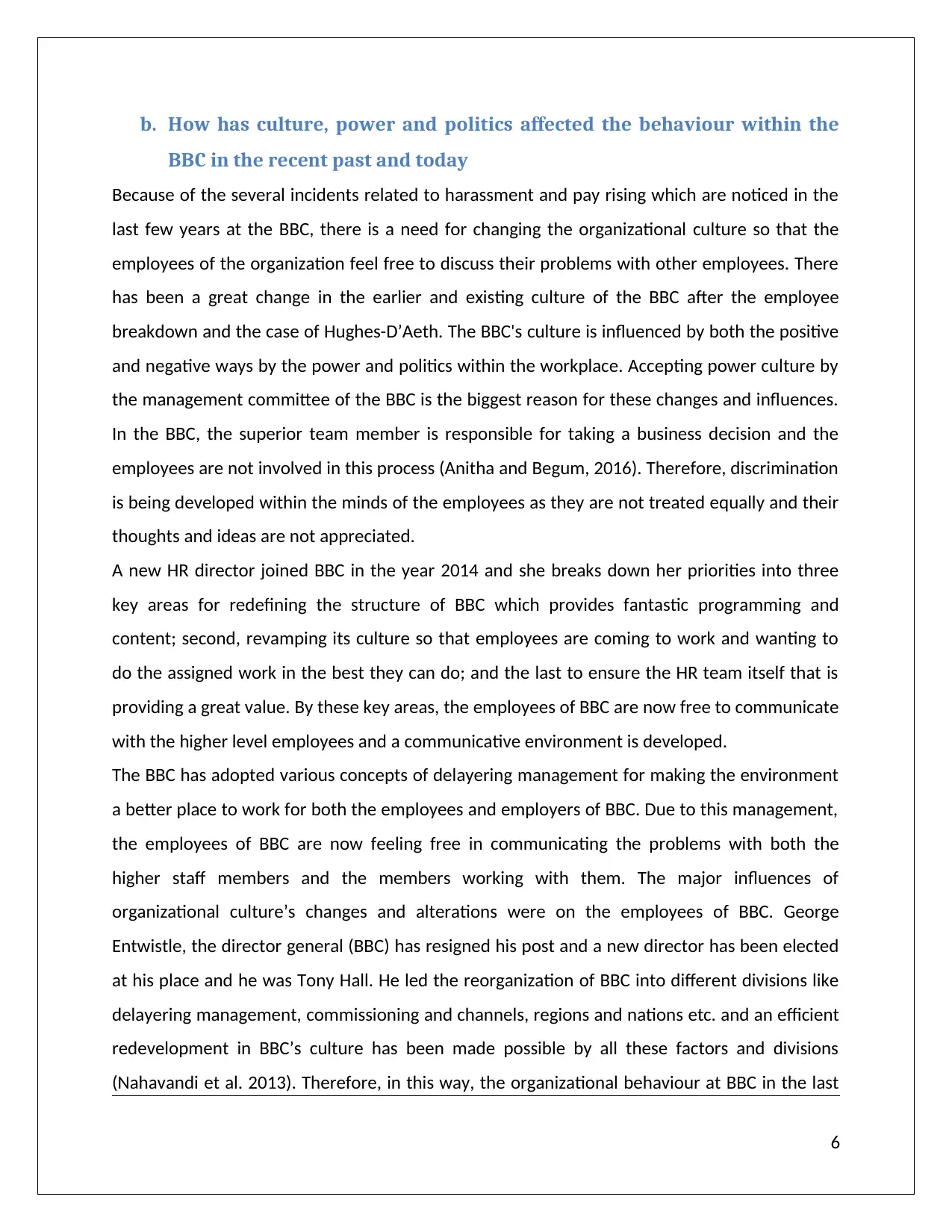
b. How has culture, power and politics affected the behaviour within the
BBC in the recent past and today
Because of the several incidents related to harassment and pay rising which are noticed in the
last few years at the BBC, there is a need for changing the organizational culture so that the
employees of the organization feel free to discuss their problems with other employees. There
has been a great change in the earlier and existing culture of the BBC after the employee
breakdown and the case of Hughes-D’Aeth. The BBC's culture is influenced by both the positive
and negative ways by the power and politics within the workplace. Accepting power culture by
the management committee of the BBC is the biggest reason for these changes and influences.
In the BBC, the superior team member is responsible for taking a business decision and the
employees are not involved in this process (Anitha and Begum, 2016). Therefore, discrimination
is being developed within the minds of the employees as they are not treated equally and their
thoughts and ideas are not appreciated.
A new HR director joined BBC in the year 2014 and she breaks down her priorities into three
key areas for redefining the structure of BBC which provides fantastic programming and
content; second, revamping its culture so that employees are coming to work and wanting to
do the assigned work in the best they can do; and the last to ensure the HR team itself that is
providing a great value. By these key areas, the employees of BBC are now free to communicate
with the higher level employees and a communicative environment is developed.
The BBC has adopted various concepts of delayering management for making the environment
a better place to work for both the employees and employers of BBC. Due to this management,
the employees of BBC are now feeling free in communicating the problems with both the
higher staff members and the members working with them. The major influences of
organizational culture’s changes and alterations were on the employees of BBC. George
Entwistle, the director general (BBC) has resigned his post and a new director has been elected
at his place and he was Tony Hall. He led the reorganization of BBC into different divisions like
delayering management, commissioning and channels, regions and nations etc. and an efficient
redevelopment in BBC’s culture has been made possible by all these factors and divisions
(Nahavandi et al. 2013). Therefore, in this way, the organizational behaviour at BBC in the last
6
BBC in the recent past and today
Because of the several incidents related to harassment and pay rising which are noticed in the
last few years at the BBC, there is a need for changing the organizational culture so that the
employees of the organization feel free to discuss their problems with other employees. There
has been a great change in the earlier and existing culture of the BBC after the employee
breakdown and the case of Hughes-D’Aeth. The BBC's culture is influenced by both the positive
and negative ways by the power and politics within the workplace. Accepting power culture by
the management committee of the BBC is the biggest reason for these changes and influences.
In the BBC, the superior team member is responsible for taking a business decision and the
employees are not involved in this process (Anitha and Begum, 2016). Therefore, discrimination
is being developed within the minds of the employees as they are not treated equally and their
thoughts and ideas are not appreciated.
A new HR director joined BBC in the year 2014 and she breaks down her priorities into three
key areas for redefining the structure of BBC which provides fantastic programming and
content; second, revamping its culture so that employees are coming to work and wanting to
do the assigned work in the best they can do; and the last to ensure the HR team itself that is
providing a great value. By these key areas, the employees of BBC are now free to communicate
with the higher level employees and a communicative environment is developed.
The BBC has adopted various concepts of delayering management for making the environment
a better place to work for both the employees and employers of BBC. Due to this management,
the employees of BBC are now feeling free in communicating the problems with both the
higher staff members and the members working with them. The major influences of
organizational culture’s changes and alterations were on the employees of BBC. George
Entwistle, the director general (BBC) has resigned his post and a new director has been elected
at his place and he was Tony Hall. He led the reorganization of BBC into different divisions like
delayering management, commissioning and channels, regions and nations etc. and an efficient
redevelopment in BBC’s culture has been made possible by all these factors and divisions
(Nahavandi et al. 2013). Therefore, in this way, the organizational behaviour at BBC in the last
6
Paraphrase This Document
Need a fresh take? Get an instant paraphrase of this document with our AI Paraphraser
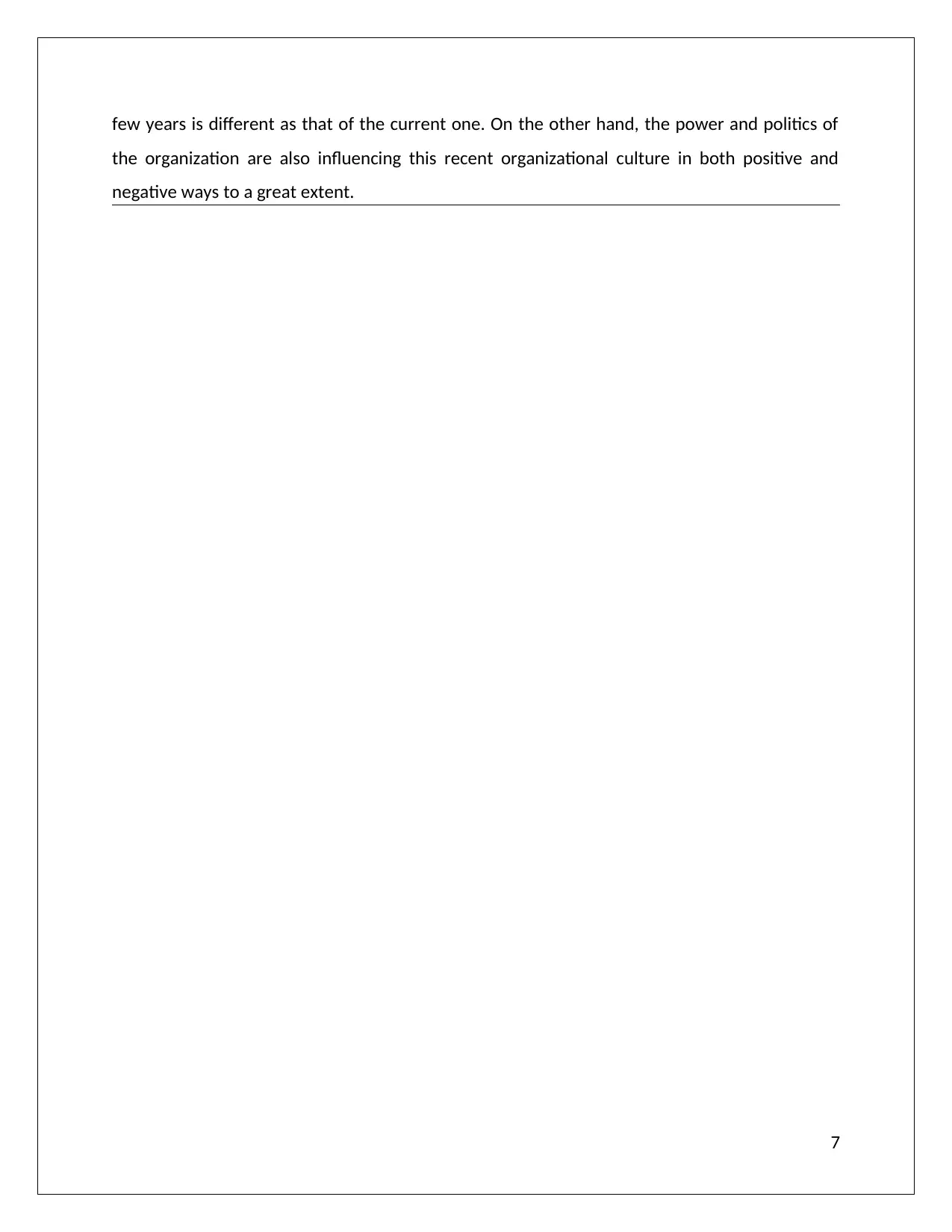
few years is different as that of the current one. On the other hand, the power and politics of
the organization are also influencing this recent organizational culture in both positive and
negative ways to a great extent.
7
the organization are also influencing this recent organizational culture in both positive and
negative ways to a great extent.
7
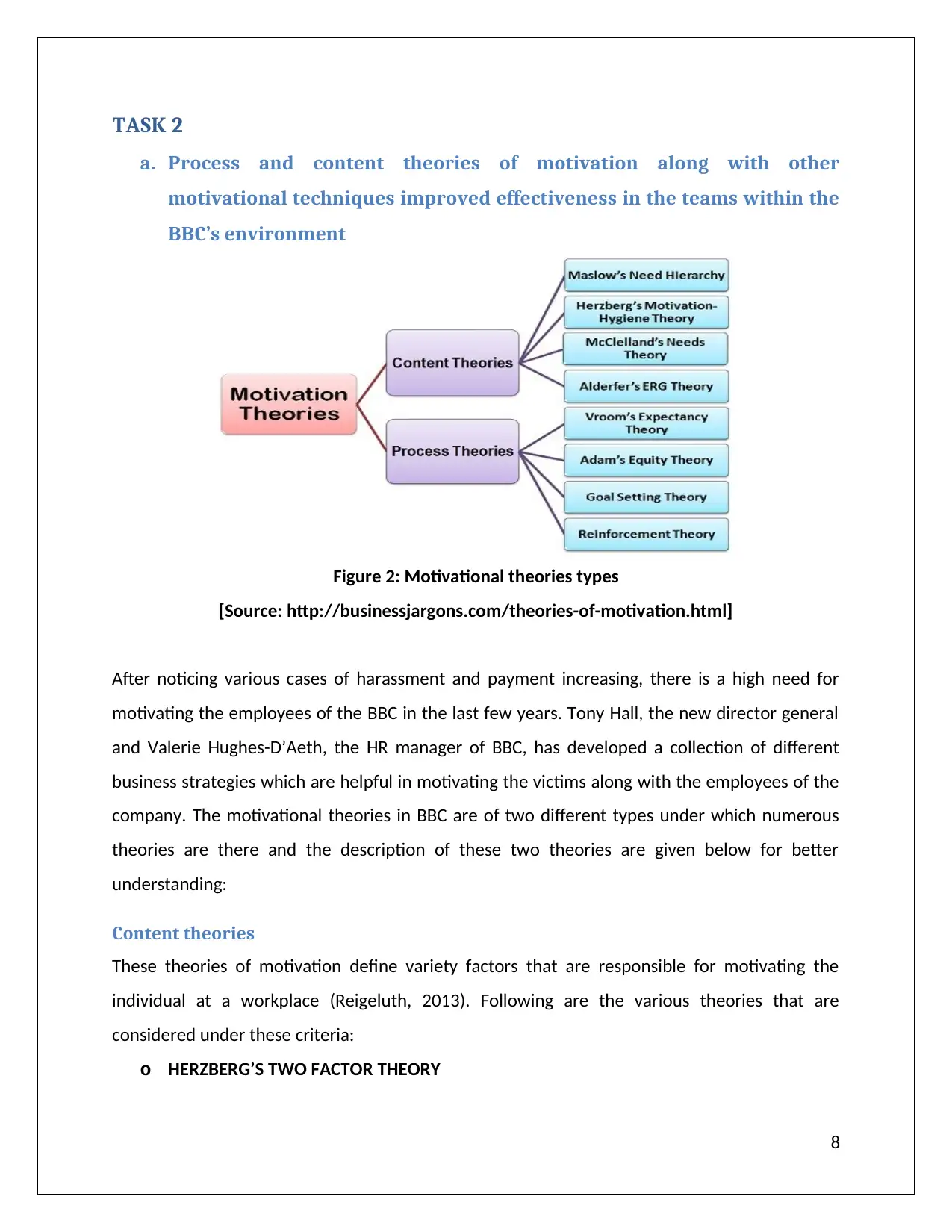
TASK 2
a. Process and content theories of motivation along with other
motivational techniques improved effectiveness in the teams within the
BBC’s environment
Figure 2: Motivational theories types
[Source: http://businessjargons.com/theories-of-motivation.html]
After noticing various cases of harassment and payment increasing, there is a high need for
motivating the employees of the BBC in the last few years. Tony Hall, the new director general
and Valerie Hughes-D’Aeth, the HR manager of BBC, has developed a collection of different
business strategies which are helpful in motivating the victims along with the employees of the
company. The motivational theories in BBC are of two different types under which numerous
theories are there and the description of these two theories are given below for better
understanding:
Content theories
These theories of motivation define variety factors that are responsible for motivating the
individual at a workplace (Reigeluth, 2013). Following are the various theories that are
considered under these criteria:
o HERZBERG’S TWO FACTOR THEORY
8
a. Process and content theories of motivation along with other
motivational techniques improved effectiveness in the teams within the
BBC’s environment
Figure 2: Motivational theories types
[Source: http://businessjargons.com/theories-of-motivation.html]
After noticing various cases of harassment and payment increasing, there is a high need for
motivating the employees of the BBC in the last few years. Tony Hall, the new director general
and Valerie Hughes-D’Aeth, the HR manager of BBC, has developed a collection of different
business strategies which are helpful in motivating the victims along with the employees of the
company. The motivational theories in BBC are of two different types under which numerous
theories are there and the description of these two theories are given below for better
understanding:
Content theories
These theories of motivation define variety factors that are responsible for motivating the
individual at a workplace (Reigeluth, 2013). Following are the various theories that are
considered under these criteria:
o HERZBERG’S TWO FACTOR THEORY
8
⊘ This is a preview!⊘
Do you want full access?
Subscribe today to unlock all pages.

Trusted by 1+ million students worldwide
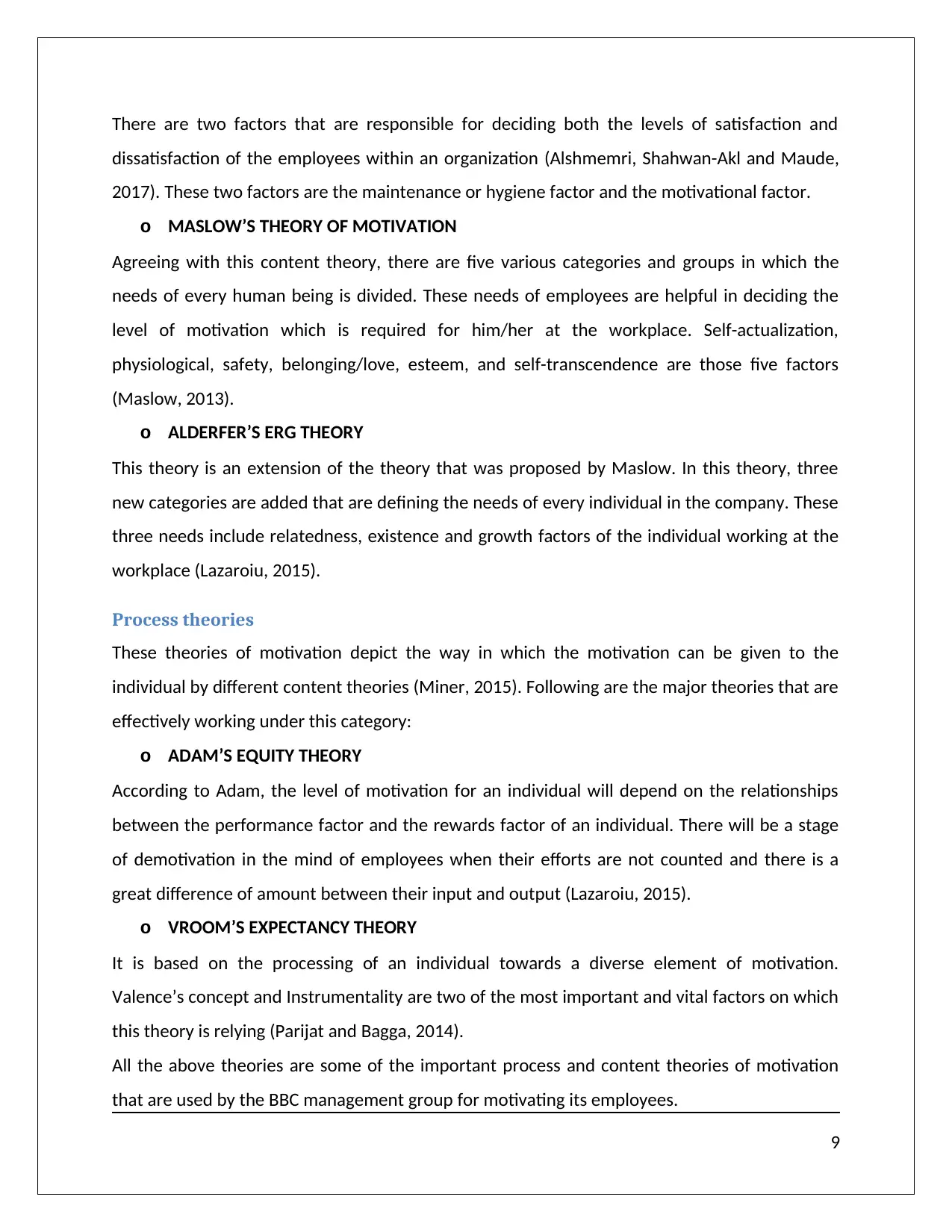
There are two factors that are responsible for deciding both the levels of satisfaction and
dissatisfaction of the employees within an organization (Alshmemri, Shahwan-Akl and Maude,
2017). These two factors are the maintenance or hygiene factor and the motivational factor.
o MASLOW’S THEORY OF MOTIVATION
Agreeing with this content theory, there are five various categories and groups in which the
needs of every human being is divided. These needs of employees are helpful in deciding the
level of motivation which is required for him/her at the workplace. Self-actualization,
physiological, safety, belonging/love, esteem, and self-transcendence are those five factors
(Maslow, 2013).
o ALDERFER’S ERG THEORY
This theory is an extension of the theory that was proposed by Maslow. In this theory, three
new categories are added that are defining the needs of every individual in the company. These
three needs include relatedness, existence and growth factors of the individual working at the
workplace (Lazaroiu, 2015).
Process theories
These theories of motivation depict the way in which the motivation can be given to the
individual by different content theories (Miner, 2015). Following are the major theories that are
effectively working under this category:
o ADAM’S EQUITY THEORY
According to Adam, the level of motivation for an individual will depend on the relationships
between the performance factor and the rewards factor of an individual. There will be a stage
of demotivation in the mind of employees when their efforts are not counted and there is a
great difference of amount between their input and output (Lazaroiu, 2015).
o VROOM’S EXPECTANCY THEORY
It is based on the processing of an individual towards a diverse element of motivation.
Valence’s concept and Instrumentality are two of the most important and vital factors on which
this theory is relying (Parijat and Bagga, 2014).
All the above theories are some of the important process and content theories of motivation
that are used by the BBC management group for motivating its employees.
9
dissatisfaction of the employees within an organization (Alshmemri, Shahwan-Akl and Maude,
2017). These two factors are the maintenance or hygiene factor and the motivational factor.
o MASLOW’S THEORY OF MOTIVATION
Agreeing with this content theory, there are five various categories and groups in which the
needs of every human being is divided. These needs of employees are helpful in deciding the
level of motivation which is required for him/her at the workplace. Self-actualization,
physiological, safety, belonging/love, esteem, and self-transcendence are those five factors
(Maslow, 2013).
o ALDERFER’S ERG THEORY
This theory is an extension of the theory that was proposed by Maslow. In this theory, three
new categories are added that are defining the needs of every individual in the company. These
three needs include relatedness, existence and growth factors of the individual working at the
workplace (Lazaroiu, 2015).
Process theories
These theories of motivation depict the way in which the motivation can be given to the
individual by different content theories (Miner, 2015). Following are the major theories that are
effectively working under this category:
o ADAM’S EQUITY THEORY
According to Adam, the level of motivation for an individual will depend on the relationships
between the performance factor and the rewards factor of an individual. There will be a stage
of demotivation in the mind of employees when their efforts are not counted and there is a
great difference of amount between their input and output (Lazaroiu, 2015).
o VROOM’S EXPECTANCY THEORY
It is based on the processing of an individual towards a diverse element of motivation.
Valence’s concept and Instrumentality are two of the most important and vital factors on which
this theory is relying (Parijat and Bagga, 2014).
All the above theories are some of the important process and content theories of motivation
that are used by the BBC management group for motivating its employees.
9
Paraphrase This Document
Need a fresh take? Get an instant paraphrase of this document with our AI Paraphraser
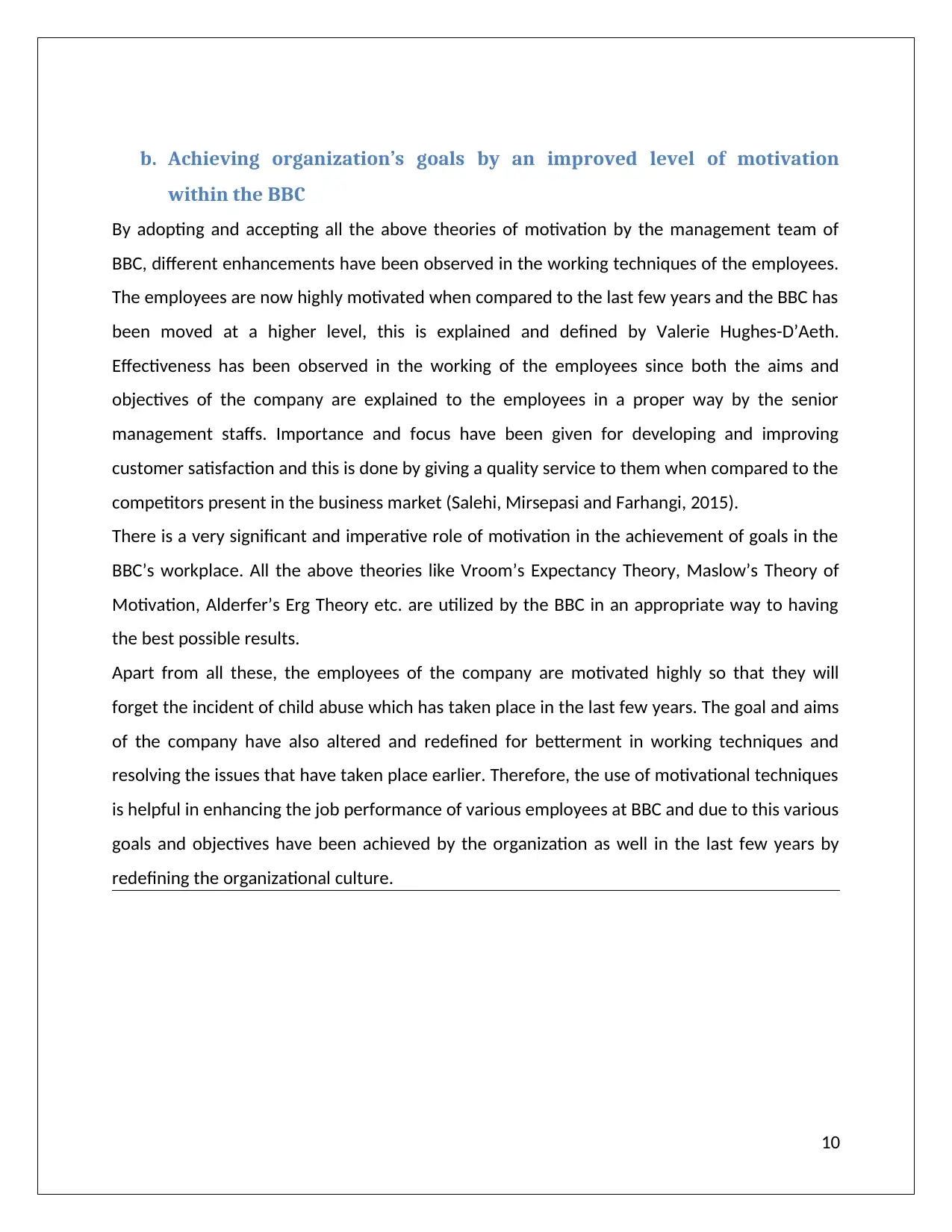
b. Achieving organization’s goals by an improved level of motivation
within the BBC
By adopting and accepting all the above theories of motivation by the management team of
BBC, different enhancements have been observed in the working techniques of the employees.
The employees are now highly motivated when compared to the last few years and the BBC has
been moved at a higher level, this is explained and defined by Valerie Hughes-D’Aeth.
Effectiveness has been observed in the working of the employees since both the aims and
objectives of the company are explained to the employees in a proper way by the senior
management staffs. Importance and focus have been given for developing and improving
customer satisfaction and this is done by giving a quality service to them when compared to the
competitors present in the business market (Salehi, Mirsepasi and Farhangi, 2015).
There is a very significant and imperative role of motivation in the achievement of goals in the
BBC’s workplace. All the above theories like Vroom’s Expectancy Theory, Maslow’s Theory of
Motivation, Alderfer’s Erg Theory etc. are utilized by the BBC in an appropriate way to having
the best possible results.
Apart from all these, the employees of the company are motivated highly so that they will
forget the incident of child abuse which has taken place in the last few years. The goal and aims
of the company have also altered and redefined for betterment in working techniques and
resolving the issues that have taken place earlier. Therefore, the use of motivational techniques
is helpful in enhancing the job performance of various employees at BBC and due to this various
goals and objectives have been achieved by the organization as well in the last few years by
redefining the organizational culture.
10
within the BBC
By adopting and accepting all the above theories of motivation by the management team of
BBC, different enhancements have been observed in the working techniques of the employees.
The employees are now highly motivated when compared to the last few years and the BBC has
been moved at a higher level, this is explained and defined by Valerie Hughes-D’Aeth.
Effectiveness has been observed in the working of the employees since both the aims and
objectives of the company are explained to the employees in a proper way by the senior
management staffs. Importance and focus have been given for developing and improving
customer satisfaction and this is done by giving a quality service to them when compared to the
competitors present in the business market (Salehi, Mirsepasi and Farhangi, 2015).
There is a very significant and imperative role of motivation in the achievement of goals in the
BBC’s workplace. All the above theories like Vroom’s Expectancy Theory, Maslow’s Theory of
Motivation, Alderfer’s Erg Theory etc. are utilized by the BBC in an appropriate way to having
the best possible results.
Apart from all these, the employees of the company are motivated highly so that they will
forget the incident of child abuse which has taken place in the last few years. The goal and aims
of the company have also altered and redefined for betterment in working techniques and
resolving the issues that have taken place earlier. Therefore, the use of motivational techniques
is helpful in enhancing the job performance of various employees at BBC and due to this various
goals and objectives have been achieved by the organization as well in the last few years by
redefining the organizational culture.
10
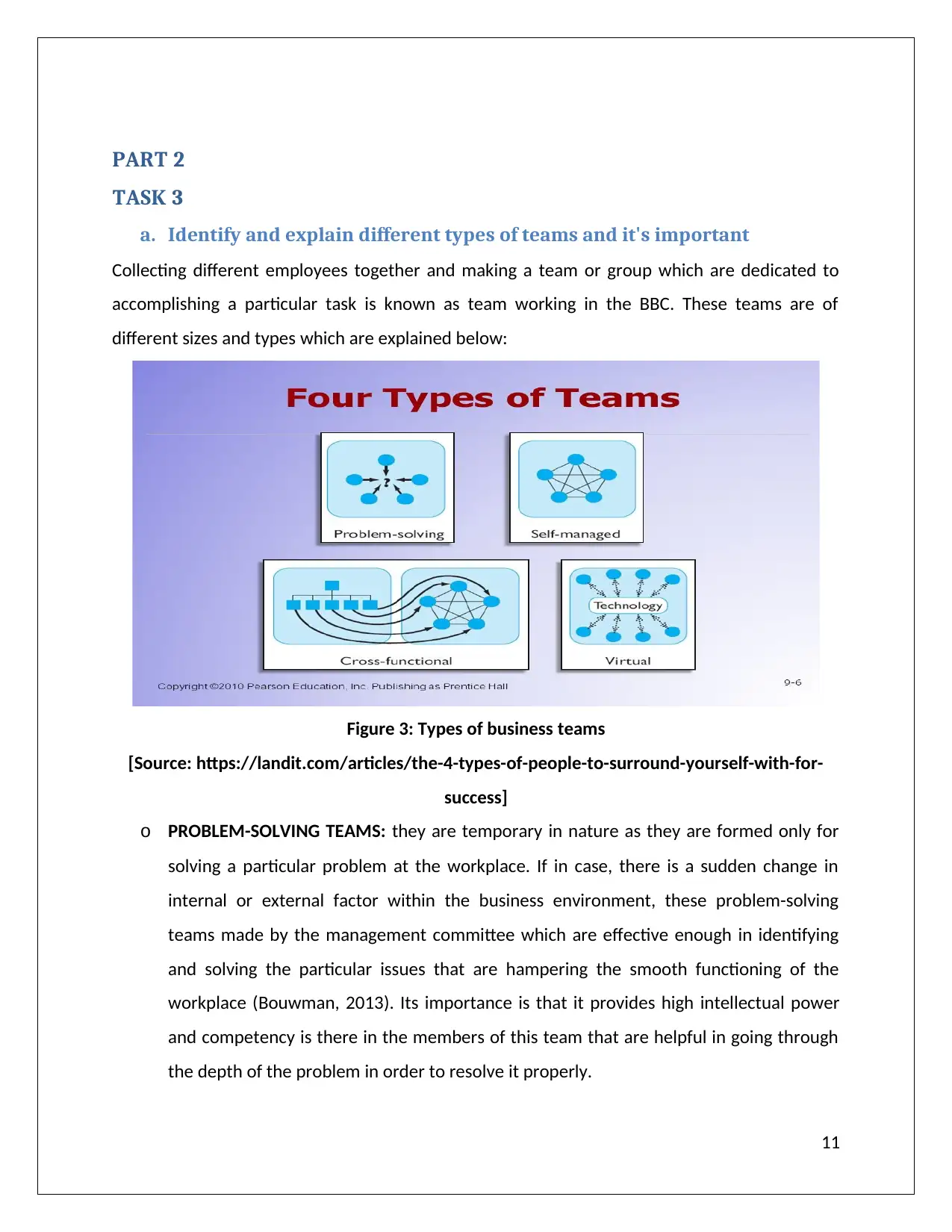
PART 2
TASK 3
a. Identify and explain different types of teams and it's important
Collecting different employees together and making a team or group which are dedicated to
accomplishing a particular task is known as team working in the BBC. These teams are of
different sizes and types which are explained below:
Figure 3: Types of business teams
[Source: https://landit.com/articles/the-4-types-of-people-to-surround-yourself-with-for-
success]
o PROBLEM-SOLVING TEAMS: they are temporary in nature as they are formed only for
solving a particular problem at the workplace. If in case, there is a sudden change in
internal or external factor within the business environment, these problem-solving
teams made by the management committee which are effective enough in identifying
and solving the particular issues that are hampering the smooth functioning of the
workplace (Bouwman, 2013). Its importance is that it provides high intellectual power
and competency is there in the members of this team that are helpful in going through
the depth of the problem in order to resolve it properly.
11
TASK 3
a. Identify and explain different types of teams and it's important
Collecting different employees together and making a team or group which are dedicated to
accomplishing a particular task is known as team working in the BBC. These teams are of
different sizes and types which are explained below:
Figure 3: Types of business teams
[Source: https://landit.com/articles/the-4-types-of-people-to-surround-yourself-with-for-
success]
o PROBLEM-SOLVING TEAMS: they are temporary in nature as they are formed only for
solving a particular problem at the workplace. If in case, there is a sudden change in
internal or external factor within the business environment, these problem-solving
teams made by the management committee which are effective enough in identifying
and solving the particular issues that are hampering the smooth functioning of the
workplace (Bouwman, 2013). Its importance is that it provides high intellectual power
and competency is there in the members of this team that are helpful in going through
the depth of the problem in order to resolve it properly.
11
⊘ This is a preview!⊘
Do you want full access?
Subscribe today to unlock all pages.

Trusted by 1+ million students worldwide
1 out of 21
Related Documents
Your All-in-One AI-Powered Toolkit for Academic Success.
+13062052269
info@desklib.com
Available 24*7 on WhatsApp / Email
![[object Object]](/_next/static/media/star-bottom.7253800d.svg)
Unlock your academic potential
Copyright © 2020–2025 A2Z Services. All Rights Reserved. Developed and managed by ZUCOL.





